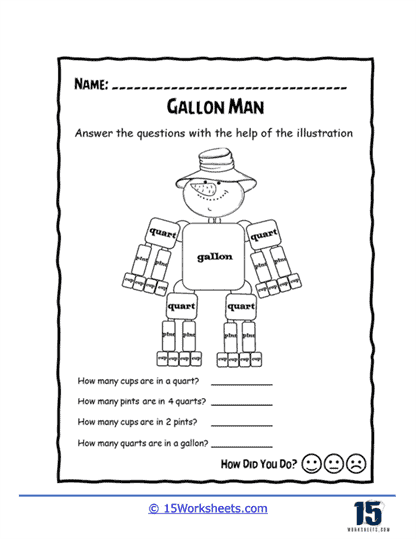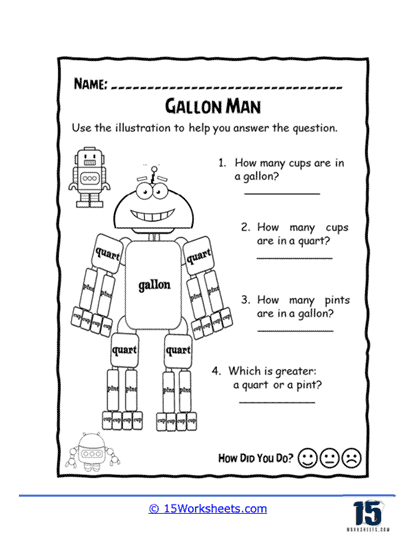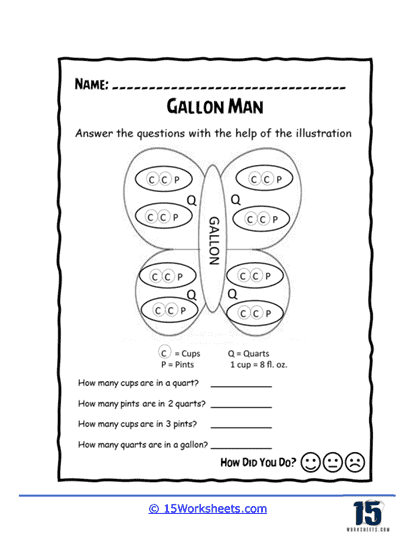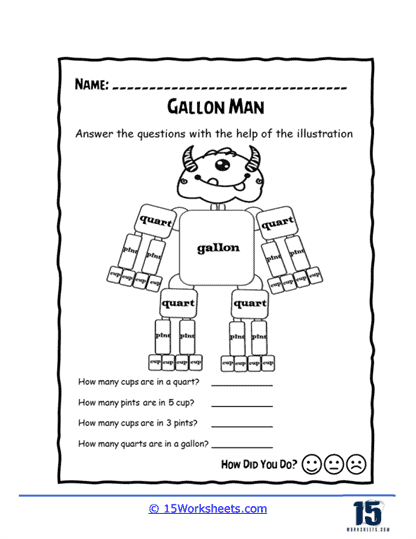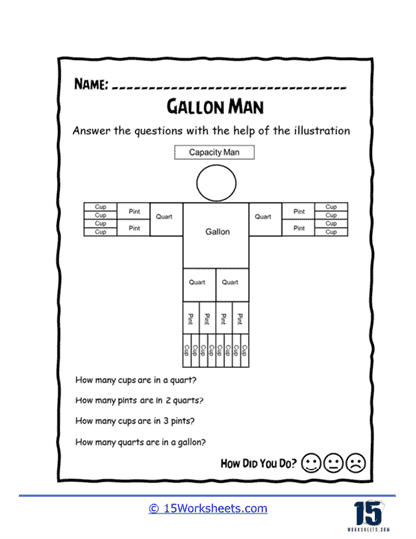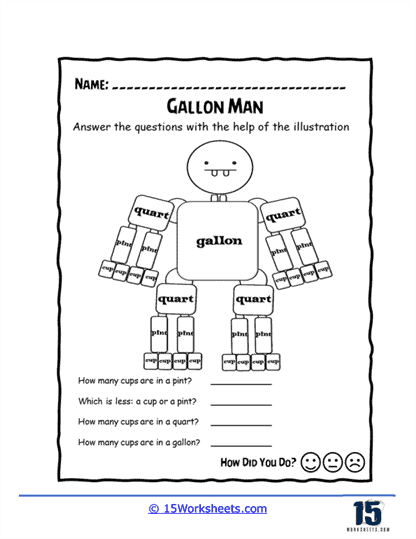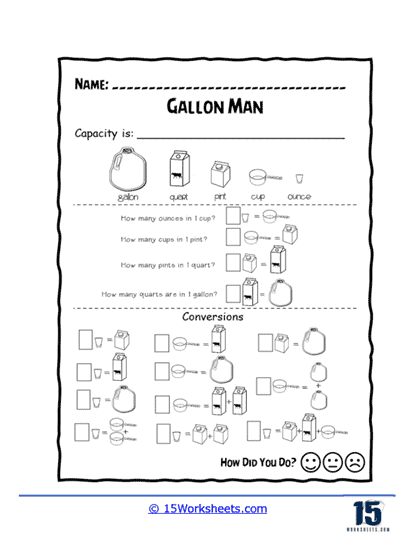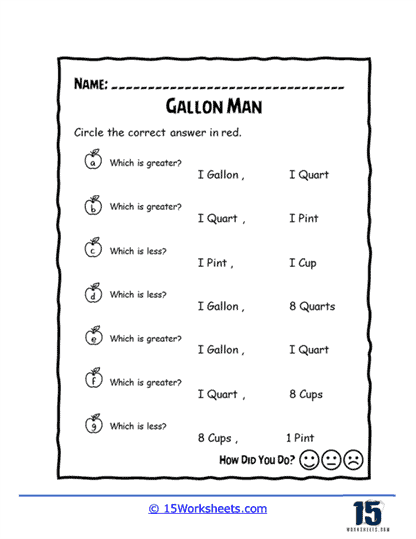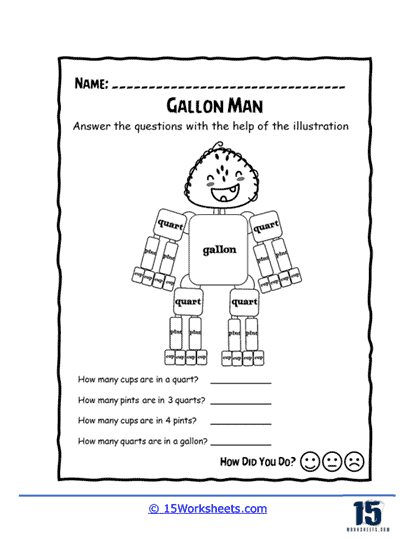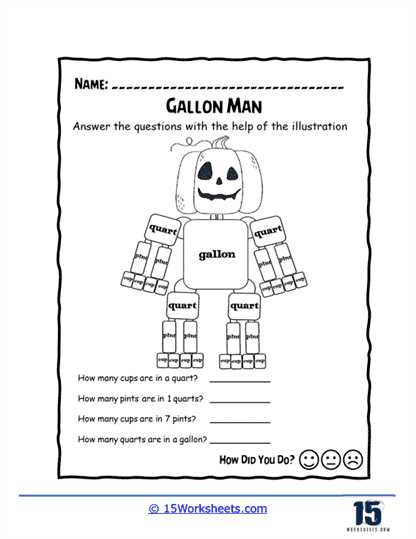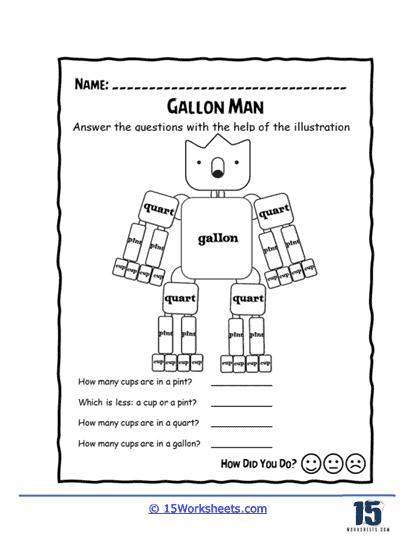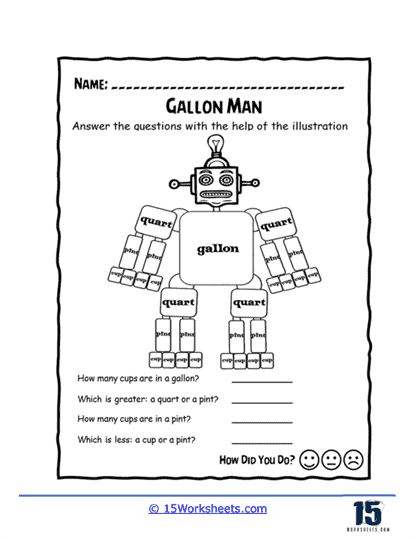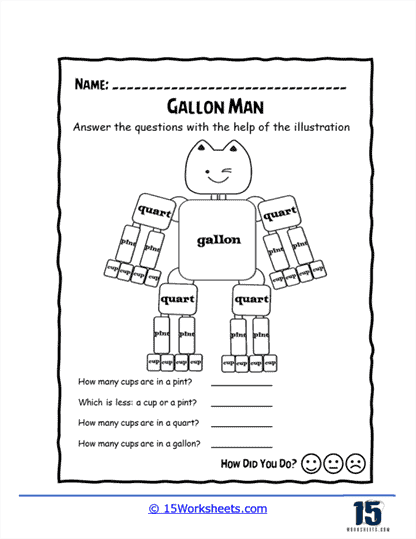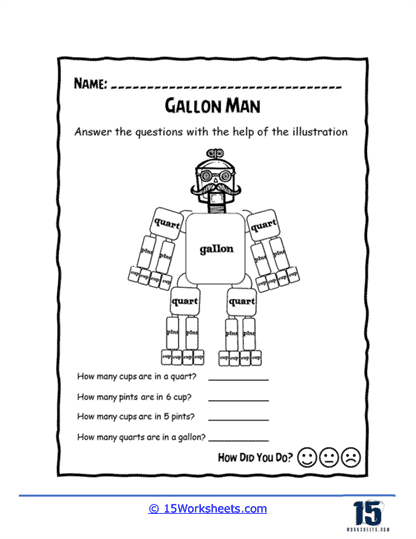Gallon Man Worksheets
About These 15 Worksheets
In the realm of measurements, especially when dealing with volumes of liquids, understanding conversions between units can be challenging. One popular mnemonic aid that educators use in the United States to teach students about these conversions is the “Gallon Man” (or “GallonBot”), a visual tool that personifies measurements. Gallon Man worksheets center around this character, enabling students to visualize and internalize the relationships between gallons, quarts, pints, and cups.
measurements. The “Gallon Man” is a visual aid that helps students remember and understand the relationships between different customary units of volume, such as gallons, quarts, pints, and cups.
The visual representation of Gallon Man are valuable tools for teaching students the conversion of units of measurement within the customary system. They make the learning process more engaging and help students grasp these concepts effectively. Teachers may use physical props, such as actual containers representing gallons, quarts, pints, and cups, to enhance the hands-on learning experience. Students can physically pour liquids from one container to another, reinforcing the conversions.
These worksheets were put together to assist students in understanding the relationships and conversions between U.S. customary units of volume. The character, “Gallon Man,” is typically drawn using a large ‘G’ to represent a gallon. This ‘G’ is then subdivided into quarts, pints, and cups, often using shapes or additional characters to represent each.
For instance:
1 Gallon (G) = 4 Quarts (Q)
1 Quart (Q) = 2 Pints (P)
1 Pint (P) = 2 Cups (C)
Hence, breaking it down, a gallon is visually represented as comprising of 4 ‘Q’s, which in turn each contain 2 ‘P’s, and so forth.
Gallon Man serves as a memorable visual aid that students can refer to when they need to convert measurements. It helps students remember the relationships between units, making it easier for them to perform conversions without the aid of worksheets in the long run.
Types of Exercises on These Worksheets
Drawing and Labeling – Students are provided with a blank or partially completed Gallon Man and are asked to fill in the missing parts or label them. This helps familiarize students with the structure of Gallon Man and reinforces the relationships between the different units. Each part of Gallon Man is labeled with the appropriate unit of measurement, such as “G” for gallon, “Q” for quart, “P” for pint, and “C” for cup. This labeling reinforces the names of each unit.
Conversion Questions – Direct conversion problems such as, “How many cups are in 3 gallons?” or “How many pints are in 2 quarts?” This tests students’ understanding of the relationships between the units and ensures they can convert between them effectively.
Multiple-choice Questions – Questions that test understanding by providing multiple answers to conversion problems, where students must select the correct one. This format evaluates the student’s ability to discern the correct conversion relationships amidst distractors.
Comparative Questions – Questions that may ask students to compare volumes, e.g., “Which is more – 7 quarts or 1.5 gallons?” This encourages students to apply conversion knowledge in a comparative context, building analytical skills.
Fill in the Blanks – Sentences that describe relationships (e.g., “There are ___ pints in a quart.”) where students must provide the correct numbers. This reinforces memorization and quick recall of basic conversion facts.
What Skills Do These Worksheet Teach?
Visual Representation – Gallon Man serves as a visual aid that students can mentally refer to when thinking about volume conversions. This visual reinforcement often makes abstract concepts more concrete, aiding in retention.
Hierarchical Understanding – By seeing how each unit fits within the larger one (cups into pints, pints into quarts, quarts into gallons), students develop a hierarchical understanding of volume measurements.
Conversion Skills – These worksheets enable students to become adept at converting between cups, pints, quarts, and gallons, a necessary skill, especially in tasks like cooking, grocery shopping, or any scenario where liquid measurement is vital.
Practical Application – Real-world scenarios on the worksheets, such as recipes or filling containers, highlight the practicality of understanding these measurements and conversions.
Critical Thinking and Problem Solving – Beyond straightforward conversion, many worksheets challenge students to apply their knowledge in varied contexts, cultivating problem-solving skills.
Engaging Learning – The character of Gallon Man provides a fun, engaging way to learn about measurements, making the learning process more enjoyable and memorable for students.
These worksheets are all about building a foundational understanding of volume in the U.S. customary system in an engaging manner. Through various exercises, these worksheets ensure students not only memorize the relationships between cups, pints, quarts, and gallons but can also apply this knowledge in practical scenarios. By transforming abstract numbers and measurements into a visual, personified character, educators have made the task of understanding and retaining this knowledge easier and more enjoyable for students. Whether in the classroom or at home, Gallon Man serves as an invaluable tool in the educational arsenal.

